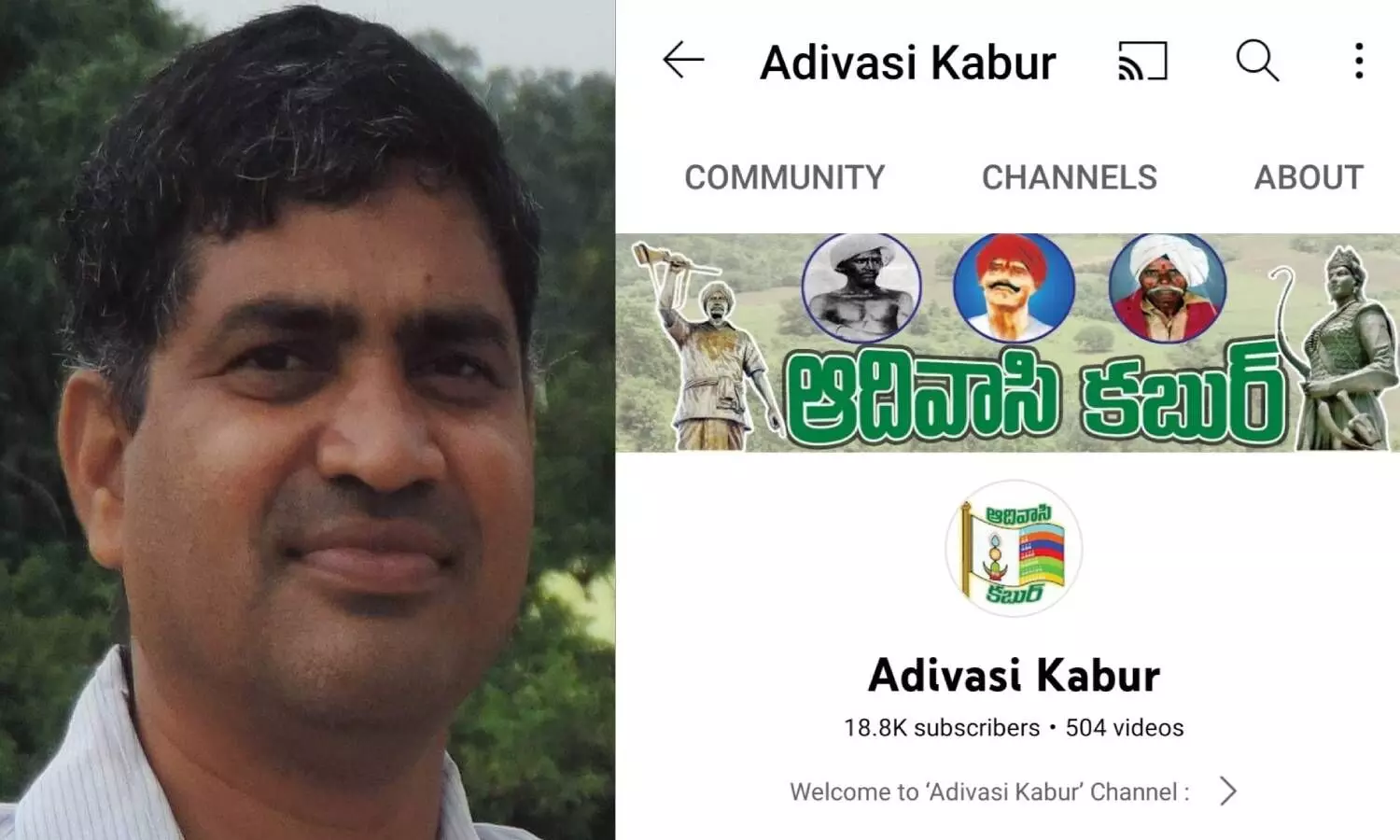Adivasi Kabur: Journalist Srinivas preserves tribal culture, empowers them through his YouTube channel
Living close to Adivasi hamlets, Srinivas has been drawn to Adivasi life since his childhood and it has been a "Ghar ki Baat" for him.
By Nimisha S Pradeep
A woman, wearing a pink sari with a yellow blouse and big necklaces and earrings, dances in front of a hut with a small basket in her hand. A man in a yellow shirt and white mundu with a yellow headband, standing opposite to her, taps rhythmically on a basket made of palm leaf in his hand and dances back in response.
A group of four men, all wearing yellow headbands, long necklaces, and anklets together dance behind the two of them. A man wearing a Dholak around his neck dances giving guest appearances throughout the song. All of them dance gleefully to the rhythm of Jajuri Sime, a Gondi (belonging to the tribal community of Gonds) song.
Not just tribal songs and dances, Adivasi Kabur, a YouTube channel of senior journalist Pillalamarri Srinivas highlights tribal lifestyle, culture, festivals, the problems faced by them, and their success stories. On February 8, the Adivasi Kabur channel with over 500 videos reached one crore views with 18,000 subscribers.
Tribal life, "Ghar ki Baat"
Pillalamarri Srinivas hails from Kagaznagar in Komaram Bheem Asifabad (in erstwhile Adilabad). Living close to Adivasi hamlets, Srinivas has been drawn to Adivasi life since his childhood and it has been a "Ghar ki Baat" for him. "I used to visit their villages and participate in their festivals as a child. When I was 14 or 15, I went for Gussadi (a dance performed by Gonds during their Dandari festival). I found their culture very unique. In this way, I developed an attachment with their community since childhood. How can I not know what is happening in my home?" asks Srinivas. His graduation in Sociology and Anthropology also helped him understand the tribal community better.
Srinivas used to take videos of Adivasi culture and post them online but at some point, he felt the need for a permanent place for his content so that it can be used as a reference by future generations. That led to the birth of 'Adivasi Kabur', a YouTube channel exclusively dealing with tribal life of tribal communities living in Telangana, Andhra Pradesh, border areas of Maharashtra, Chattisgarh, etc. in March 2018.
Srinivas learnt a lot of new skills like video editing, voice-over, etc. from his friends in the course of the journey of `Adivasi Kabur'.
Srinivas, who has been working with the Deccan Chronicle (DC) for the last 18 years, religiously manages to find time for his channel amid his busy reporting schedules. "Whenever, I go out reporting for DC, parallelly, I shoot videos for my channel also. For video editing, I sit from 11 pm to 1 am, after finishing my reports for DC," says Srinivas. It's hard but relaxing as well, admits Srinivas.
Srinivas earns a meager Rs. 2,000 to Rs. 3,000 per month from his YouTube channel, but he ensures to contribute some financial assistance to Adivasis for their medical emergencies, educational purpose, etc.
During COVID-19, Srinivas conducted many awareness programmes, especially by inviting some of the Adivasi doctors to explain to the Adivasis, the prevention measure to be taken in their own language. He received special appreciation from Telangana government for the same.
Language not a barrier
Initially, Srinivas was not familiar with the Gondi language but over time he learnt it. Now he can understand as well as explain to some extent in Gondi. He also says that most of the tribal people speak Hindi so it was never a problem for him.
Contrary to the common perception that Adivasis hesitate to open up to a third person, Srinivas says they are more liberal now. "There has been a change in their lifestyle, they have started migrating to other areas, visiting markets, and mixing with non-tribal people. Yes, they do get annoyed when you don't remove your chappals while entering their homes but they are liberal now in their interactions with an outsider," says Srinivas.
Also, Srinivas tries to overcome this third-person barrier by making them happy with his work. Featuring their unique songs, dances, and other life practices in Adivasi Kabur makes them happy. He creates awareness about education, health care, and fighting for their rights in a democratic way.
Education, the only way out
"Education is the only tool which can change their lives, help their generations," says Srinivas.
Srinivas believes his greatest success has been in encouraging Adivasi students to pursue higher education. "Now, many Adivasi students are getting into NITs, and IITs, which is a welcoming change. Recently, we organized a felicitation programme for 15-20 Adivasi students including girls from remote areas who secured admission to NIT Warangal," he says. Srinivas, using his Twitter page has also mobilized funds for some of the tribal students who got admission into higher education institutions but were unable to join due to financial hardships.
Another inspiring change has been the Adivasi youth themselves making videos and telling their stories. "This is very important as they can narrate their stories better rather than a third person doing it," says Srinivas.
Media coverage on tribal life
Srinivas recalls when he started his channel, there was very little coverage on Adivasis in mainstream media. Twenty years ago, it was only Hyderabad/city issues that mattered, but now things have changed, he says.
"Nowadays, local reporters contact me to get content from Adivasi Kabur," he says.
Srinivas's photos and videos have also been used by organizations like the BBC Telugu by giving due credits.
Beyond everything, Srinivas says it's his way of compensating the Adivasis who were oppressed historically by preserving their unique culture.
Check out YouTube channel Adivasi Kabur here